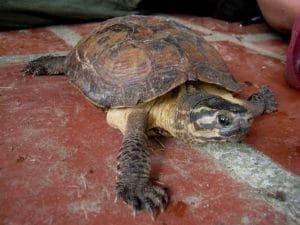Rhinoclemmys rubida (Mexican Spotted Wood Turtle)
Home > Turtle Database > Rhinoclemmys rubida (Mexican Spotted Wood Turtle)

Rhinoclemmys rubida, commonly known as the Mexican Spotted Wood Turtle, is a terrestrial species native to Mexico. It is known for its striking shell pattern and preference for humid forested environments. Despite its adaptability, habitat loss poses a threat to its population.
Native Turtle Species Map – Find Turtles by Region
Scientific Classification
Kingdom: Animalia
Phylum: Chordata
Class: Reptilia
Order: Testudines
Family: Geoemydidae
Genus: Rhinoclemmys
Species: Rhinoclemmys rubida
Common Names
Mexican Spotted Wood Turtle
This Hilarious Turtle Book Might Know Your Pet Better Than You Do
Let’s be real—most turtle care guides feel like reading a textbook written by a sleep-deprived zookeeper.
This one’s not that.
Told from the snarky point of view of a grumpy, judgmental turtle, 21 Turtle Truths You’ll Never Read in a Care Guide is packed with sarcasm, sass, and surprisingly useful insights.
And hey—you don’t have to commit to the whole thing just yet.
Grab 2 free truths from the ebook and get a taste of what your turtle really thinks about your setup, your food choices, and that weird plastic palm tree.
It’s funny, it’s honest, and if you’ve ever owned a turtle who glares at you like you’re the problem—you’ll feel seen.
Identification
Description
The Mexican Spotted Wood Turtle has a slightly domed, oval-shaped carapace with reddish-brown coloration and dark markings. The plastron is lighter with faint patterns. Its skin is dark brown or gray, often with orange or yellow markings on the head and limbs.
Sexual Dimorphism
Males tend to have longer, thicker tails and a more concave plastron, while females have a flatter plastron and shorter tails. Males may also have brighter coloration on the head and neck.
Check more turtles from the Rhinoclemmys genus
Native Origin and Distribution
Geographical Range
This species is endemic to Mexico, primarily found along the Pacific slopes in the states of Oaxaca and Chiapas.
Preferred Habitat
Mexican Spotted Wood Turtles inhabit humid, forested areas, particularly near streams, rivers, and other freshwater sources. They prefer shaded environments with ample leaf litter and vegetation.
Behavior
Feeding Habits
They are omnivorous, consuming a variety of plant matter, fruits, fungi, and small invertebrates such as insects and worms. Their diet varies based on seasonal availability of food.
Predators
Predators include birds of prey, mammals, and larger reptiles. Hatchlings and juveniles are especially vulnerable due to their smaller size.
Reproduction
Breeding Season
Breeding occurs during the rainy season, typically between late spring and early summer when conditions are more favorable for nesting.
Reproductive Method
Females lay small clutches of eggs in loose soil or leaf litter. Incubation periods vary depending on temperature and humidity, with hatchlings emerging after several months.
Conservation
Extinction Status
Currently, Rhinoclemmys rubida is classified as Near Threatened by the IUCN due to habitat destruction and other environmental pressures.
Threats
Deforestation, agricultural expansion, and human encroachment are the primary threats to this species. The pet trade also contributes to population decline in some areas.
Conservation Measures
Efforts to protect its natural habitat through forest conservation initiatives and legal restrictions on capture are essential for its survival. Raising awareness about its ecological role may also help reduce human impact.
Economic Importance
This species is occasionally kept in the pet trade, though its specific habitat needs make it challenging to maintain in captivity. It also plays a role in ecosystem balance by controlling insect populations and dispersing seeds.
Interesting Facts
- Unlike many turtles, this species is more terrestrial and spends much of its time on land rather than in water.
- Its reddish-brown shell helps it blend into the forest floor, providing natural camouflage against predators.
- The Mexican Spotted Wood Turtle is one of the least studied members of the Rhinoclemmys genus, with much of its behavior still undocumented.

About Author
Muntaseer Rahman started keeping pet turtles back in 2013. He also owns the largest Turtle & Tortoise Facebook community in Bangladesh. These days he is mostly active on Facebook.














